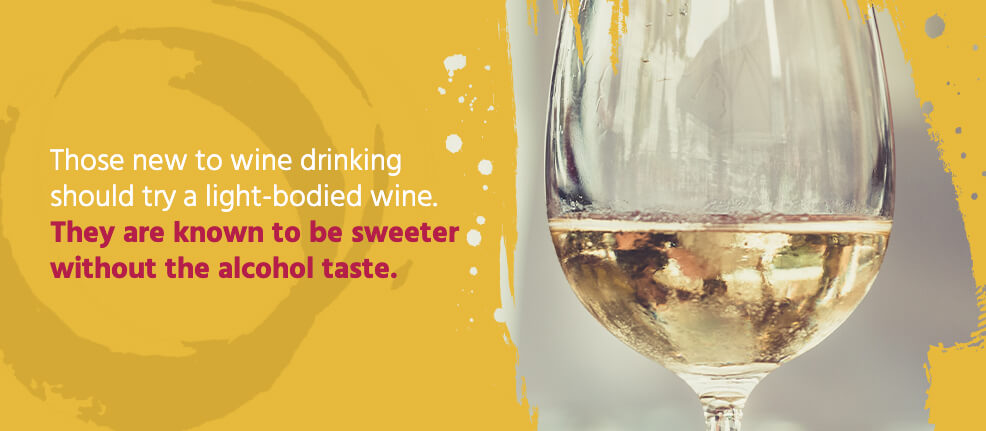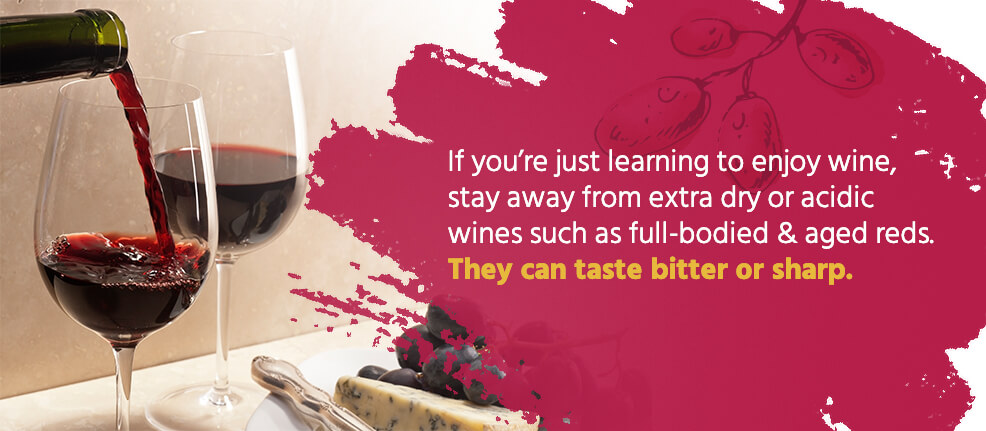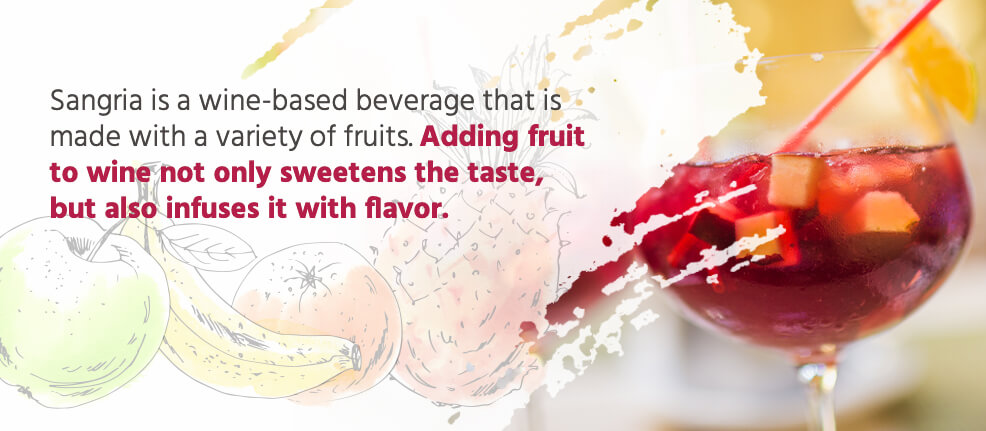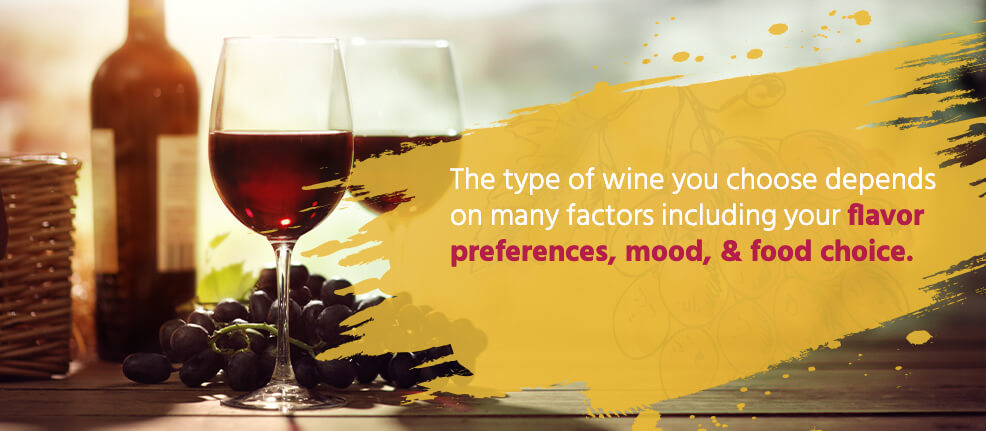The popularity of wine in our society can’t be denied. From wine tastings and painting parties to slogans on t-shirts and signs, wine drinking has become not only a popular pastime, but also a lifestyle. In 2016 alone, 399 million cases of wine were shipped to the U.S. from both domestic and foreign producers, with sales totaling over 60 billion dollars.
It may seem like everyone is jumping on the wine bandwagon. However, there are still many people out there who are just learning to like wine or dislike it for one reason or another.
Reasons Why People Don’t Like Wine
There are many reasons why people don’t like wine. Some don’t care for the sharp alcohol taste they may have experienced with previous wine-drinking experiences. Others may not have acquired a taste for wine or have tasted a style of wine they didn’t like. Many people don’t like the way that wine feels in their mouth or may have experienced an unpleasant aftertaste.
The fact that there are hundreds of varieties of wines can also be incredibly intimidating to some people. They may not be sure which wines they might like and what characteristics each type embodies. Many people are confused about wine and food pairings, too, so spending money on a glass of wine they’re unsure about when dining out also leads some people to skip the wine-drinking experience altogether.

Perhaps you feel like the only one in your social circle who doesn’t drink wine. Maybe you want to find a wine you like but aren’t sure where to start. Don’t worry — whether you’re searching for an appropriate variety or are just desperately trying to fit in with your wine-loving peers, even if you hate the taste of wine, there’s a wine out there for you.
If you don’t enjoy the taste of wine, chances are it’s because you’ve been drinking the wrong kind. Fortunately, learning to like wine is actually quite simple. Although there is a vast variety of wines from which to choose, from sweet and fruity to bold and rich, learning some of the basic terminology and styles of wine can help you narrow down the flavors you enjoy. There are also many helpful tips to help you identify and enhance the flavors of your wine and make your wine-drinking experience more enjoyable. With the right wine style, you may not even realize you’re drinking wine.
Basic Wine Vocabulary: Wine Body
When discussing wine, the term “body” is often mentioned. This refers to the wine’s weight, fullness or overall feel in your mouth. Since there is no definitive cutoff between the categories, wines can fall into more than one. A wine’s body has nothing to do with its quality, which is determined by other factors such as how all of the components work together.
Alcohol content is the primary factor that determines a wine’s body, with higher alcohol levels making a more viscous and full-bodied wine. Components such as tannins, sugars and acids are referred to as “extracts” and also contribute to a wine’s body. Certain winemaking techniques, such as how the wine is aged, processed or fermented also contribute to a wine’s body. The grape variety is another contributing factor to a wine’s overall body since grapes with higher sugar content produce more alcohol and a fuller-bodied wine.
Here’s a more in-depth look:
- Light-bodied wines: Wines with an alcohol level of up to about 12.5% are considered light-bodied. These wines are generally described as delicate and easy-drinking. Both red and white wines can fall into the light-bodied wine category, although red wines tend to be more full-bodied naturally. Light bodied wines are often sweeter without the alcohol taste that is often associated with wine. Light-bodied wines are perfect for beginning wine drinkers.

- Medium-bodied wines: Wines with an alcohol level of about 12.5% to 13.5% are considered medium-bodied. Their flavor falls between the light and sweet tones of light-bodied wines and the powerful tones of full-bodied wines. They are considered to be light on the palate and are not as heavy and acidic as full-bodied wines. Medium-bodied wines are perfect for wine drinkers who want to appreciate their wine without the extreme flavors of light or full-bodied wines.
- Full-bodied wines: Wines with an alcohol level over 13.5% are considered full-bodied. They are often described as robust and powerful. Red wines are typically more full-bodied than white wines, although both may fall into this category. Wines that are aged or fermented in oak barrels are more full-bodied, as are those that are made from grapes with thicker skins or grown in warmer climates. Full-bodied wines are appropriate for wine drinkers who enjoy strong tastes and a wine flavor that will linger in their mouth.
The Nine Basic Styles of Wine
While learning about the types of grapes that are used for each style of wine is also very helpful in determining the types of wine you may like, identifying specific grape varieties may prove to be a challenging and time-consuming task. There are over 1,300 varieties of commercial wine grapes, with only about 150 varieties used in wine produced around the world.
Although there are numerous varieties of wine available in the world today, they can be broken down into nine basic styles that describe their flavor, body and characteristics. These styles encompass the broad range of wine flavors that exist. Starting off at one of these basic wine styles can help you to eventually branch out into other similar flavors and varieties:
- Sparkling Wine
Sparkling wines are described as light and bubbly. While many sparkling wines are sweet, the brut varieties are not.
Varieties include:
Within the style of sparkling wine are four different flavor categories that include:
- Dry and zesty
- Dry, fruity and floral
- Sweet and aromatic
- Creamy and nutty
Flavors you may experience with sparkling wines include fruit, flowers, nuts and even bread and yeast. The flavors of each wine are dependent upon the types of grapes used and the fermentation and aging processes. Sparkling wines pair well with salty foods, salads, seafood such as fish and oysters, and chili. Sparkling wines are best served ice-cold.
- Light-Bodied White Wine
These wines are described as light and zesty. They are popular because they’re refreshing, easy to drink and pair well with most foods.
Varieties include:
- Pinot Grigio
- Sauvignon Blanc
- Soave
Crisp, acidic, fruity flavors are usually experienced in light-bodied white wines, which pair well with seafood, fried foods, salads and chicken or other poultry. Light-bodied white wines are best served cold.
- Full-Bodied White Wine
The flavors of these wines are described as smooth and creamy, due to special techniques such as barrel aging. Red wine fans enjoy this style of white wine since there are many flavor similarities.
Varieties include:
- Chardonnay
- Marsanne
- Sèmillon
Flavors that may be encountered in full-bodied white wines include coconut and vanilla. This style of wine pairs well with shellfish such as crab and lobster, rich cream sauces, poultry and soft cheeses. Full-bodied white wines are best served cool.
- Sweet White Wine
These wines are described as sweet and aromatic with both sweet and dry varieties available. The grapes used for this style of wine have a perfume-like flavor that gives the wine its inherent sweetness.
Varieties include:
- Moscato
- Riesling
Flavors that may be encountered in sweet white wines include fruity and floral notes. They pair well with Indian and Thai cuisine, cream sauces, dishes containing citrus, dessert foods and strong cheeses. Sweet white wines are best served cold.
- Rosé Wine
This style of wine gets its rosy color from the skins of red wine grapes. It is described as fruity and crisp and is available in both dry and sweet varieties. The delicate flavors of rosé are more fully experienced in the dry variety. Rosé is a diverse wine that bridges the span between red and white wine.
Varieties include:
- Grenache
- Syrah
- White Zinfandel
Flavors you may experience in rosé wines include red and citrus fruits, flowers, melon and rhubarb. They pair well with Mexican, Greek, Turkish and Lebanese cuisine, fried chicken, roast pork and foods containing exotic spices. Rosés are best served at cool room temperature.
- Light-Bodied Red Wine
This style of red wine is described as pale in color and light-tasting. These wines are very popular and desired around the world since they combine the complex flavors of red wine without the high, sharp-tasting tannin content.
Varieties include:
- Pinot Noir
- Beaujolais
Flavors you may encounter in light-bodied red wines include those of red fruits. They pair well with creamy foods, chicken and other poultry. Light-bodied red wines are best served at cool room temperature.
- Medium-Bodied Red Wine
This wine style is very popular since it pairs well with many types of foods. It can be described as zesty and flavorful. This style of red wine is an easy-drinking wine for enjoying with dinner.
Varieties include:
- Merlot
- Zinfandel
- Grenache
Flavors that may be experienced with medium-bodied red wines vary greatly like the regions in which their grapes are grown and can include those of both dark and soft fruit. These wines pair well with a wide variety of foods including Italian cuisine, hamburgers, hearty soups, roasted meats and foods with strong spices. Medium-bodied red wines are best served at room temperature.
- Full-Bodied Red Wine
This style of red wine contains the most tannins and is a deep and dark color. Their flavor is described as sharp and bold. These wines pair well with high-fat foods such as steak, but they are also delightful by themselves. Full-bodied red wines are known for cleansing the palate, which makes them a great cocktail wine.
Varieties include:
Flavors you may experience in full-bodied red wines include rich, dark fruit flavors. They pair well with barbecued, smoked and red meats, along with Mexican food and dishes containing black pepper. Full-bodied red wines are best served at room temperature.
- Dessert Wine
This style of wine, made from sweet grapes, is usually intense and flavorful. These wines are frequently enjoyed as after dinner drinks, as their sweetness and viscosity liken them to a dessert treat. Dessert wines are available in both dry and sweet varieties.
Varieties include:
Dessert wines are available in several different types including sparkling, slightly or richly sweet and also fortified. Many different flavors may be encountered in dessert wines including those of figs, raisins, florals, fruits, nuts, yeast, ginger, honey and even brown sugar. The different types of dessert wines pair nicely with certain foods such as strong cheeses and dessert foods, and they are also frequently enjoyed by themselves. The serving temperature of dessert wines varies according to the variety.
Wine-Drinking Tips
Once you know the basic terminology and styles of wine, you’ll have a better idea of what kind of wine to ask for the next time you’re out for dinner or cocktails. However, you may still be a little confused. What happens if you are given a bottle of unfavorable wine as a gift and need to toast a glass as the gracious host, or if you’re at a wedding and they only offer a style of wine you don’t like? Fortunately, there are many ways to help make your wine drinking experience a pleasant one, even if the wine you are offered is not your favorite:
- Stay away from extreme flavors. If you’re just learning to enjoy wine, focus on lighter and sweeter wines like sparkling wines, light-bodied whites or rosé. Stay away from extra dry or acidic wines, like full-bodied and aged reds and as they can be bitter and sharp. While focusing on sweeter wines is a good tip for beginning wine drinkers, it’s important to stay away from overly sweet wines, such as dessert varieties, which can be unpleasant if consumed in large quantities.

- Identify flavors you like. Since wine embodies many different flavor notes, from fruits and nuts to flowers and chocolate, knowing the types of flavors you enjoy in both food and beverages can help you to choose a proper wine variety. Some other flavors that can be found in different wine varieties also include: Coffee, Hops, Yeast, Honey, Spices, and Herbs.
- Choose wines that pair well with foods you enjoy. While different varieties of wine are best paired with specific foods, it’s impossible to remember all of the pairing rules. A good basic rule of thumb is that white wines pair well with chicken, pork and fish, while red wines pair best with beef and lamb.
- Add fruit. The addition of fruit to wine not only sweetens the taste, but also infuses it with a flavor boost. Try to choose fruits that are already present in your wine. Strawberries, raspberries, oranges, lemons and limes are fruits that are commonly added to wine. Additionally, sangria is a wine-based beverage that is made with a variety of fruits such as apples, peaches and citrus. It’s also available in both white or red wine varieties.

- Chill your wine. Chilling your glass of wine may help to enhance its flavor and make it more palatable. Certain wines, such as white and sparkling varieties, are best served ice cold, while others, such as reds are best served at room temperature. Adding an ice cube or even frozen bits of fruit chills your wine and also dilutes it.
- Dilute your wine. Don’t be afraid to dilute a strong-tasting wine with an ice cube or even some club soda. The addition of carbonation can greatly cut the sharpness and aftertaste of a strong wine. Consider ordering a wine spritzer, as it will be already mixed with correct ratio of wine to club soda.
- Drink it while eating cheese. Cheese makes everything better, and wine is no exception. The saltiness and pungent flavor of cheese can cut the sharp flavor of wine, and each helps to bring out the flavor of the other. While certain varieties of wine go best with certain cheeses, there really is no bad combination when it comes to wine and cheese.
Suggested Wines for People Who Hate the Alcohol Taste
Here is a quick cheat sheet to use as a reference when considering wine choices. The following varieties of wine tend to be sweeter and lack the burn, bitterness and alcoholic taste that turn many people off to wine. Remember that dry wines tend to be more earthy and less fruity, while dessert wines are meant to be sipped slowly:
White/Sparkling Wines:
Rosé Wines:
Red Wines:
- Grenache
- Pinot Noir
- Sangria (Made with red or white wine)
Dessert Wines:

The type of wine you ultimately choose depends on many factors, including your flavor preferences, mood and food choice. When picking wine as a beginner, it’s best to purchase through a specialty wine store with great selection, service and savings. At Marketview Liquor, our knowledgeable and helpful staff can guide you in choosing the wine varieties that are right for you. Browse our extensive selection of wines and have your perfect wine shipped directly to your door.
